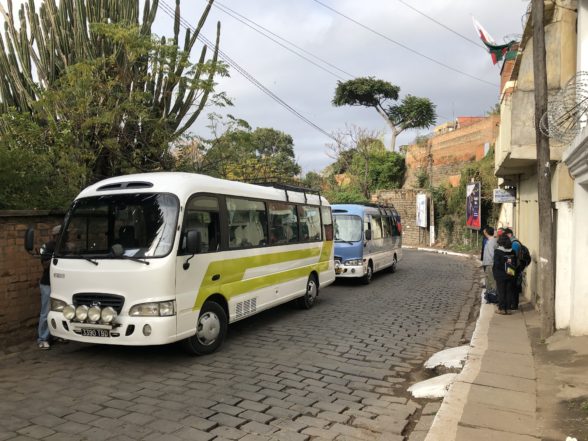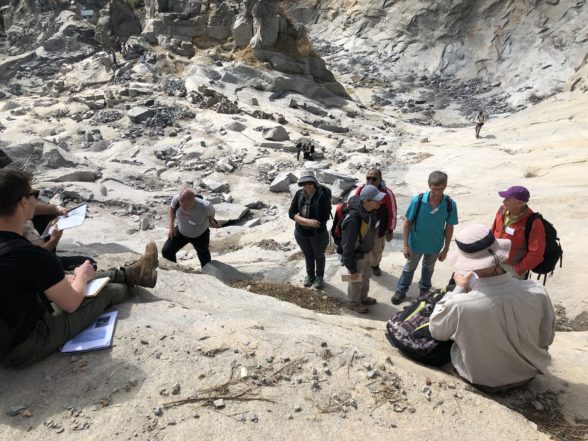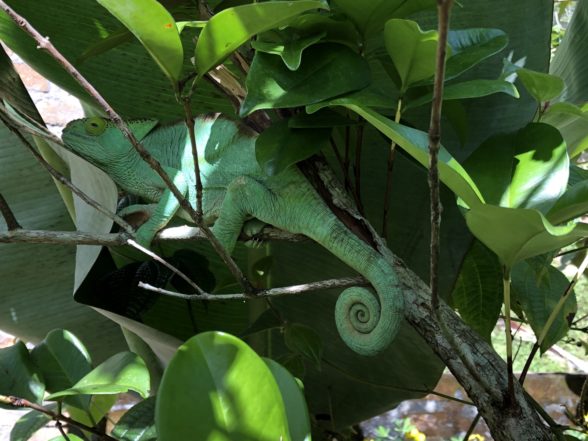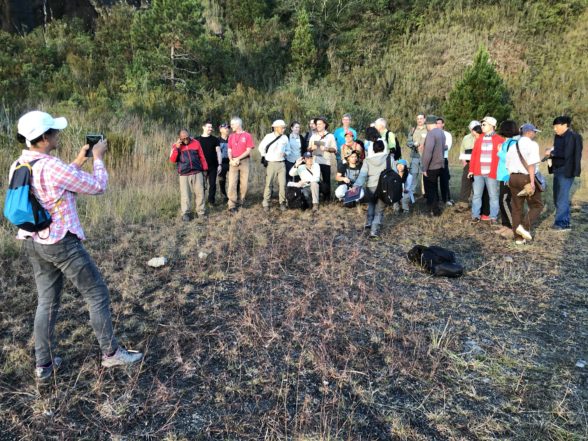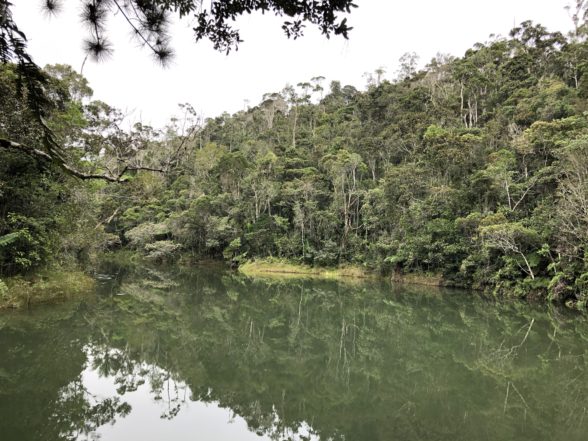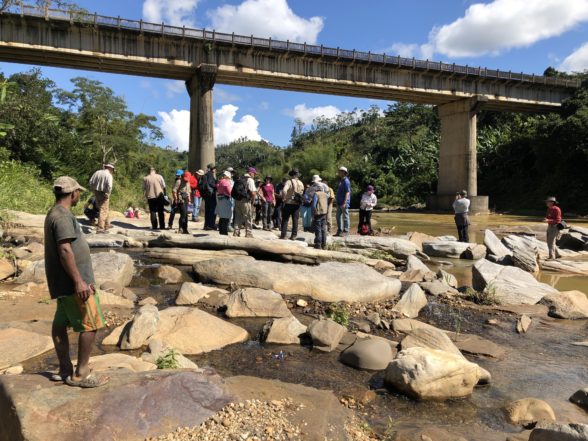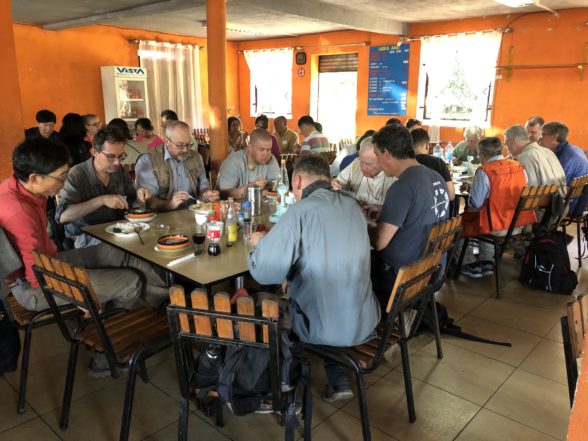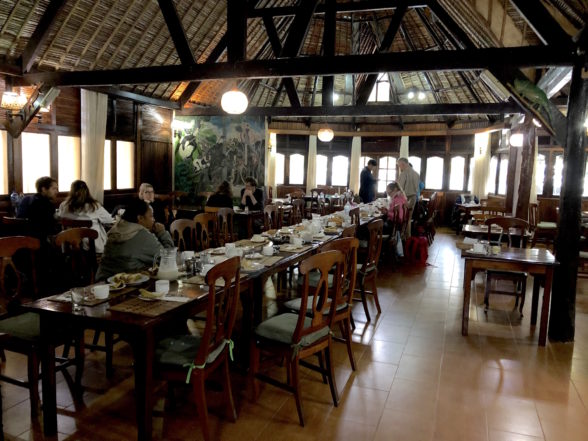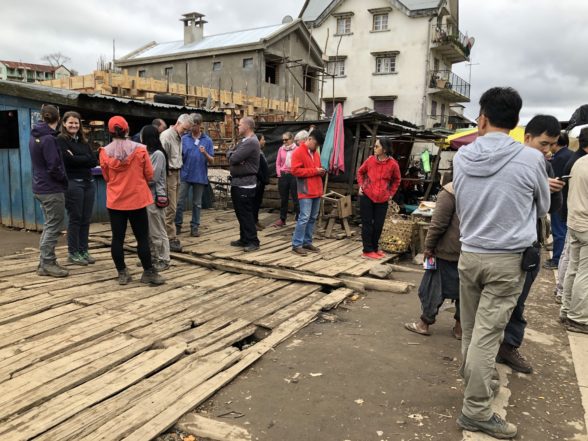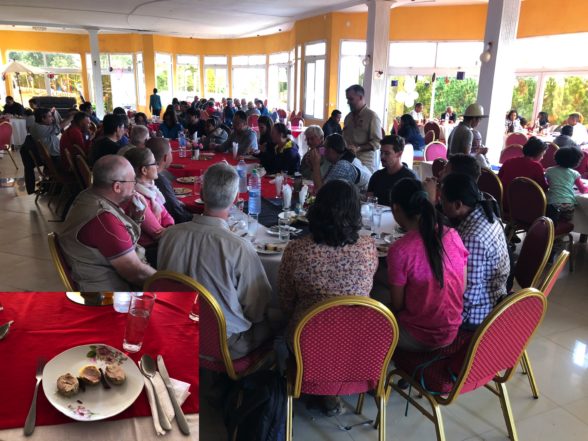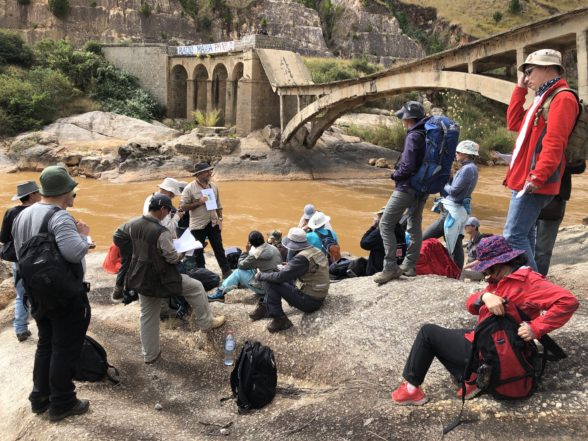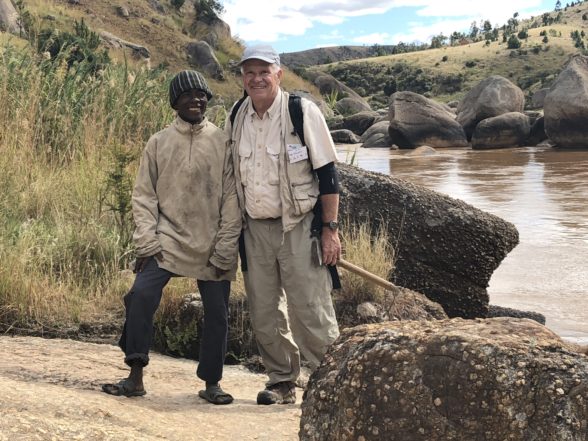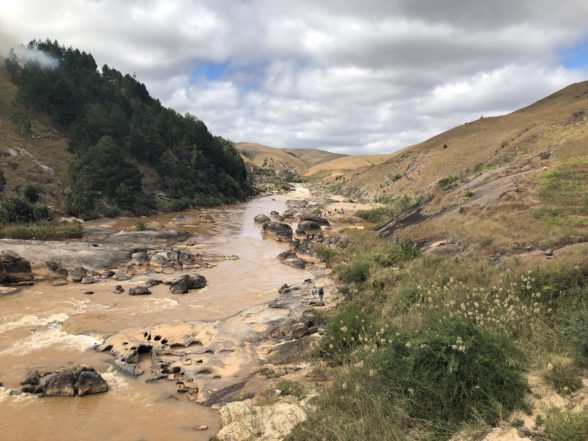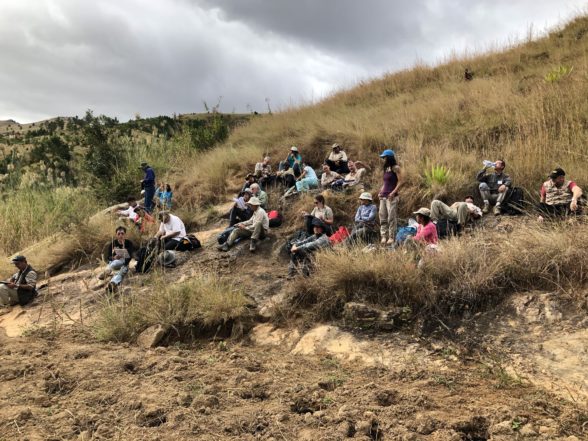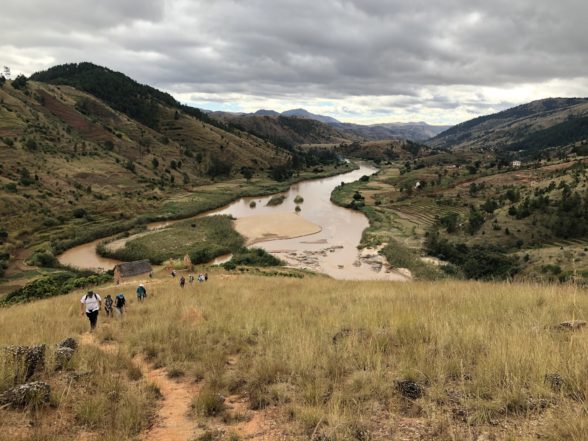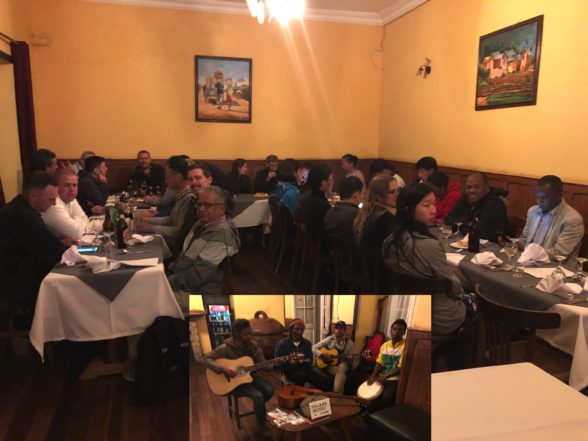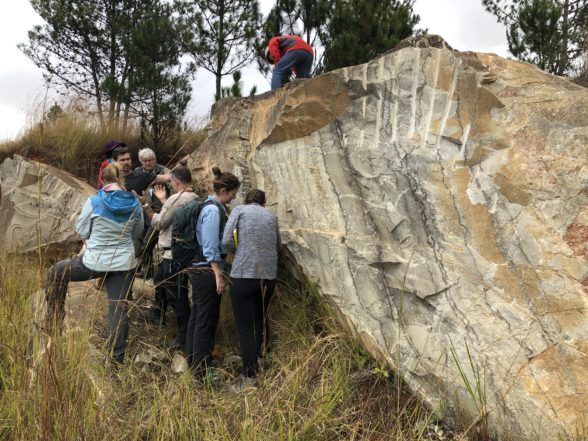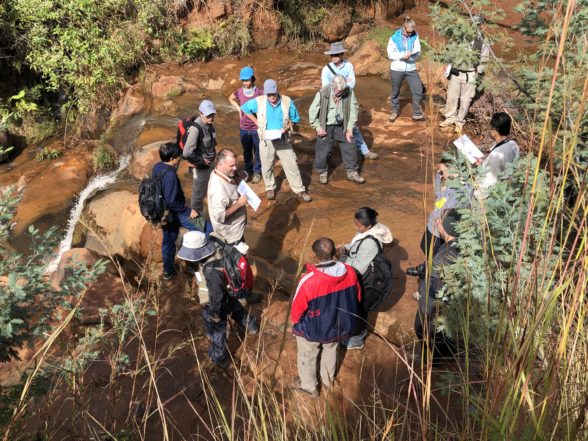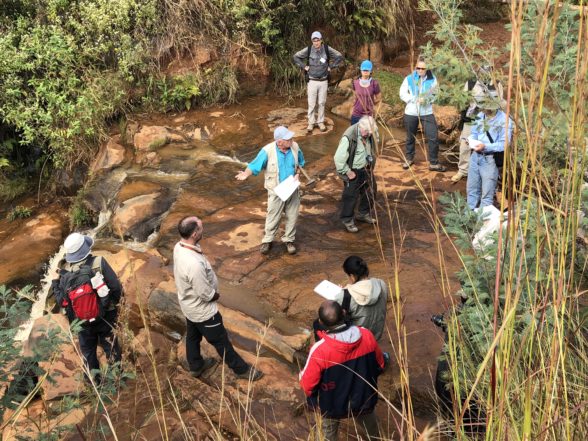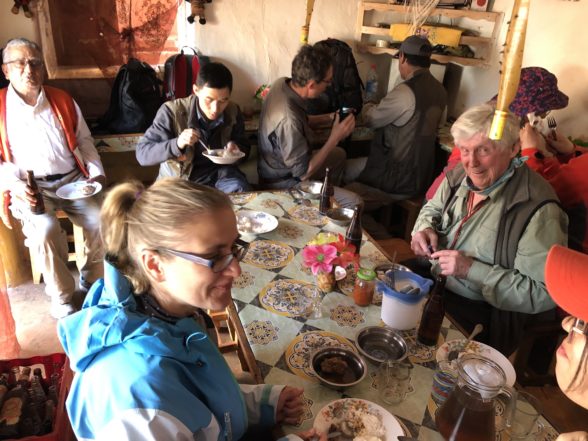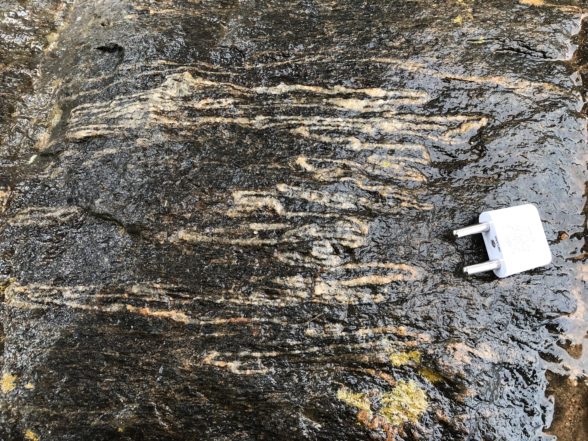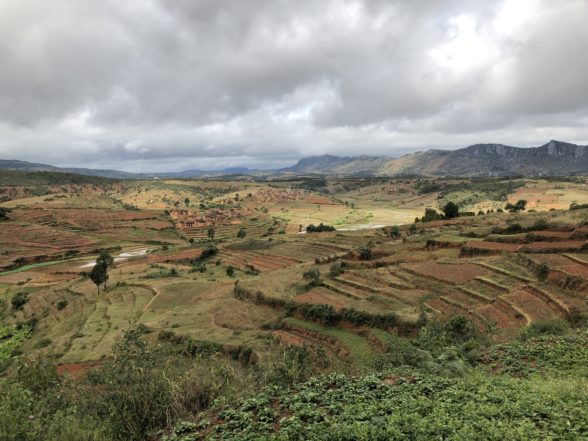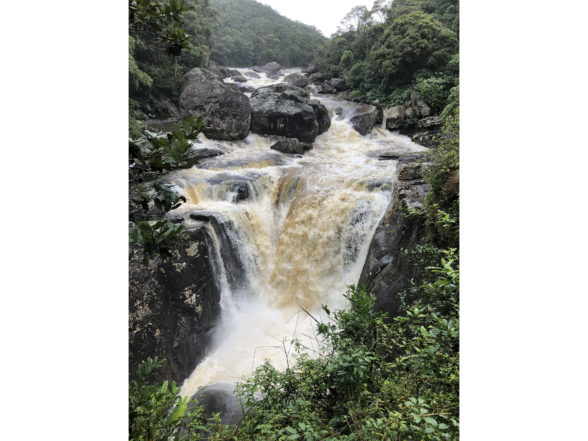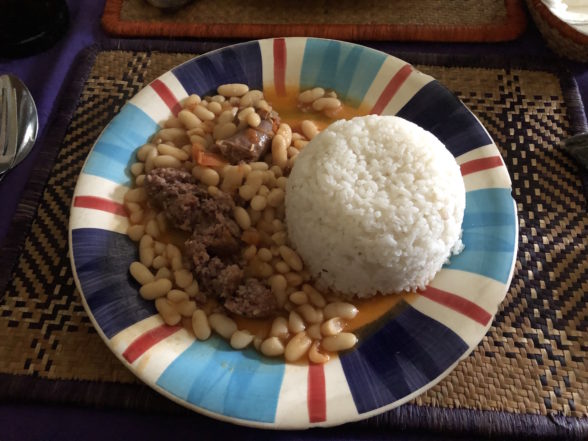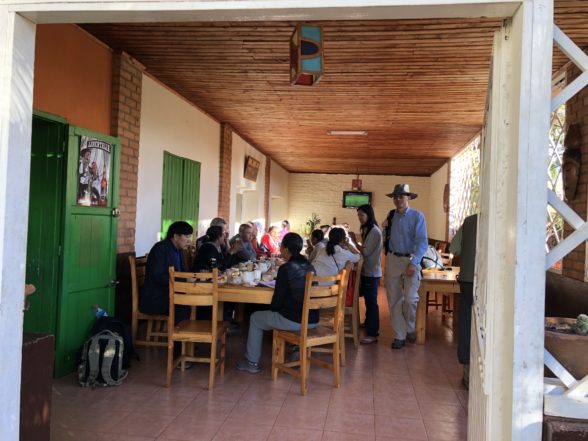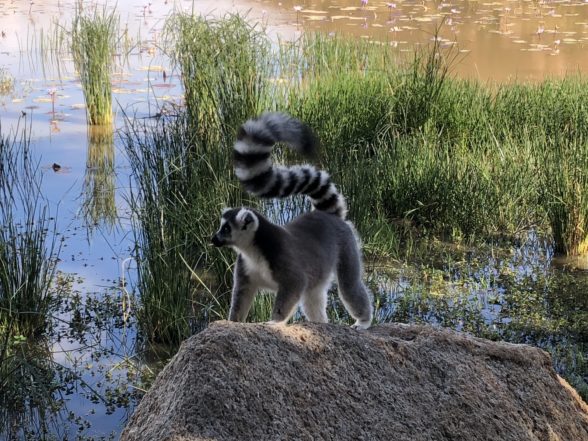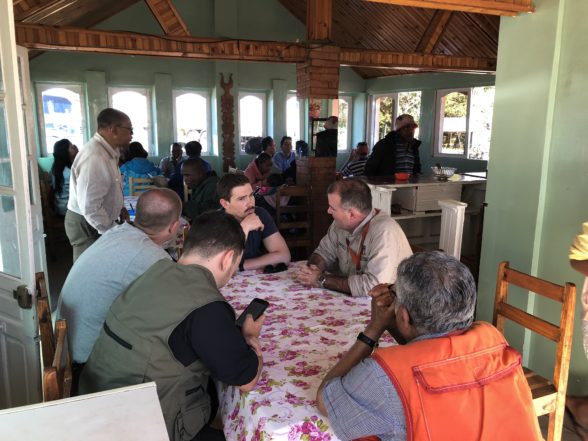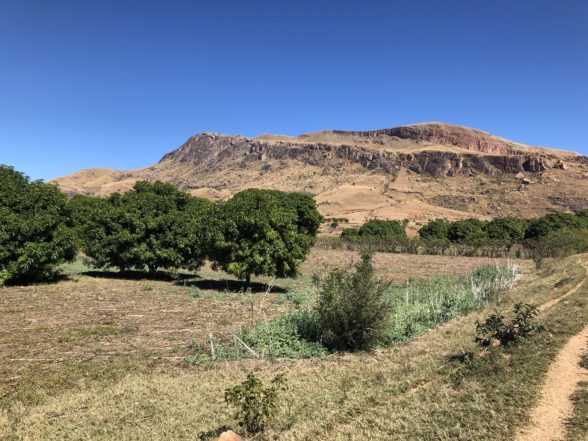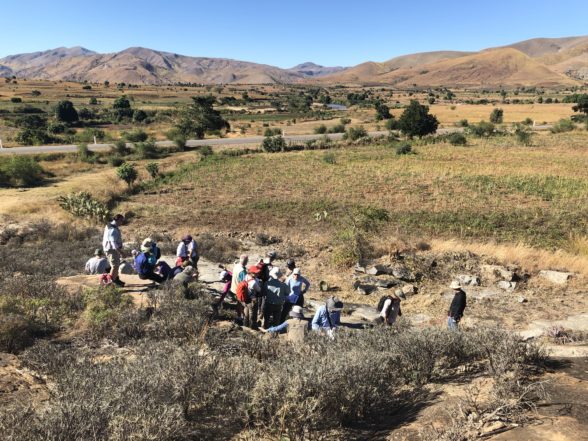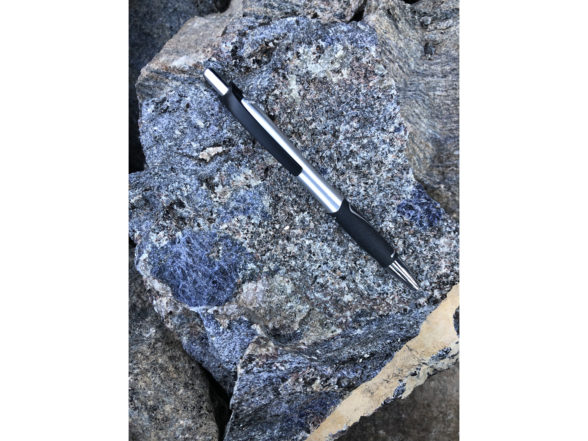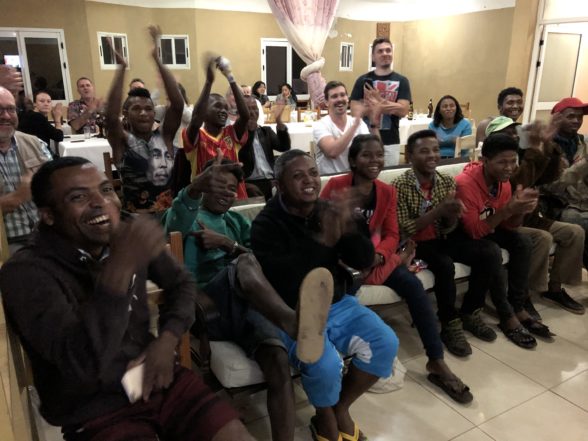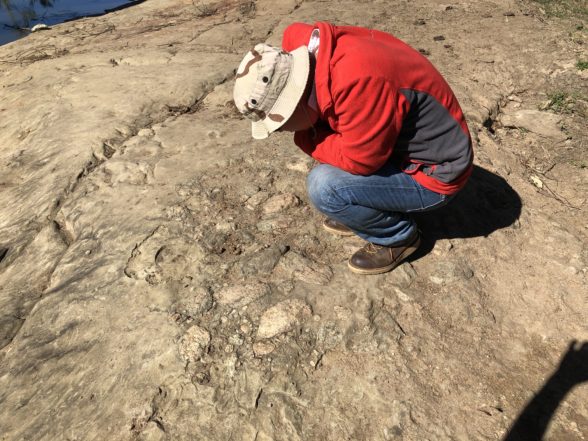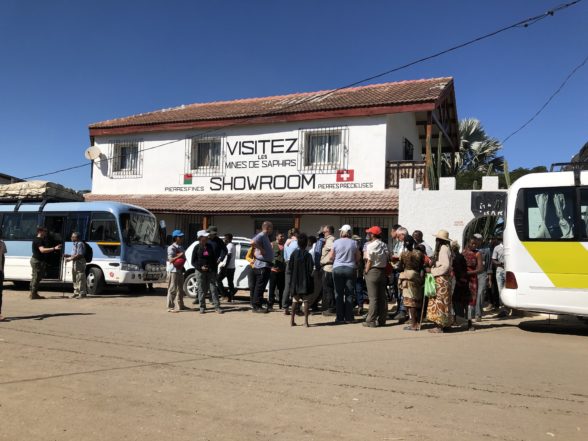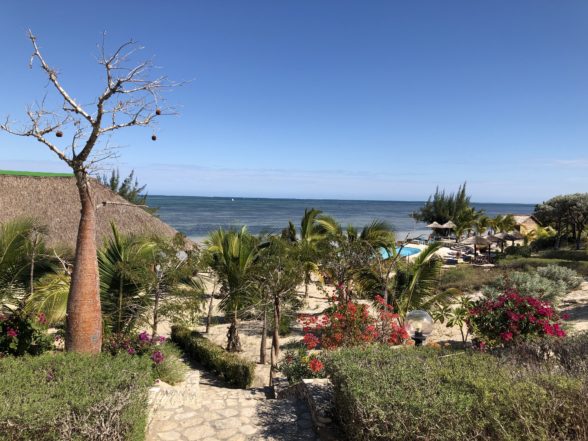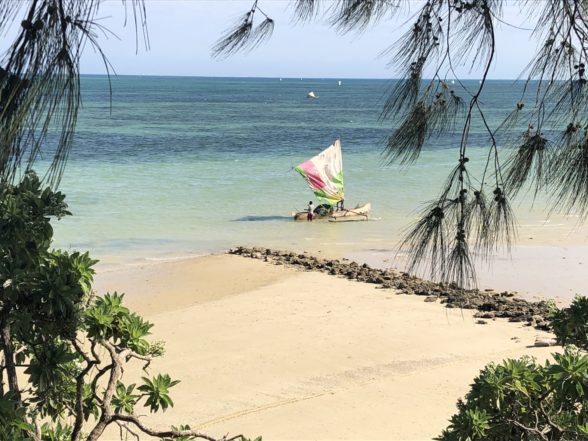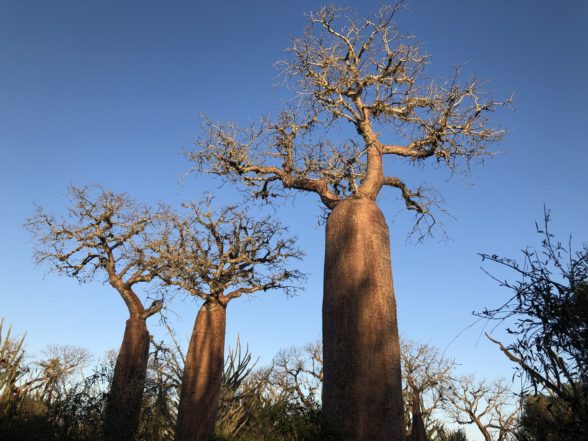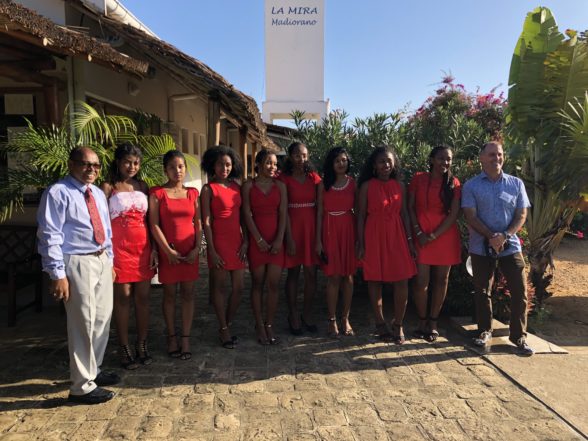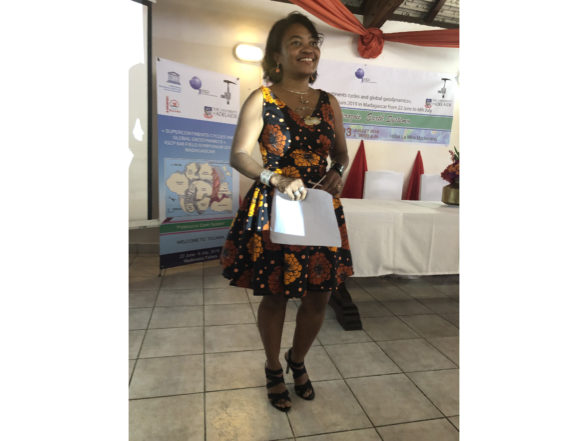IGCP 648 2019 Field Symposium
Geologic Transect of Madagascar
22 June – 6 July, 2019 | Berforona to Toliara, Madagascar
By Damian Nance
At 5 pm on Saturday 22nd June, 2019, 31 geoscientists from eleven countries on six continents and the subcontinent of India met at the Tana Jacaranda Hotel in Antananarivo, Madagascar, for the start of the IGCP 648 2019 Field Symposium on the Precambrian evolution of Madagascar, the geology of which is pivotal to the reconstruction of several supercontinents. The symposium began with a nine-day geologic transect of the country from Berforona in the east to Toliara in the southwest, and ended with a two-day conference at the La Mira Madioriano resort on the coast at Ifaty. Despite significant logistical difficulties, both the field trip and conference were superbly well organized by Professors Théodore Razakamanana (Université de Toliara), the conference convener, and Alan Collins (University of Adelaide), the conference co-chair, with the invaluable assistance of Drs. Morgan Blades, the conference secretary, and Sheree Armistead (University of Adelaide), fresh from defending her doctoral dissertation on the amalgamation of central Gondwana with a focus on Madagascar and India.
Following a memorable meal at the Sakamanga (Blue Cat) on Saturday night, Sunday 23rd June saw the start of the field trip, a central theme of which was the ongoing controversy over the provenance (African or Indian) of much of the country’s basement. Adding to the intellectual calibre (and entertainment) of the meeting, the principal advocates of both models were present – Alan Collins and his past doctoral students, who argued that the Archean domains and their Proterozoic cover sequences west of the controversial Betsimisaraka suture and the Indianderived Antogil-Masora domain along the country’s eastern coast were of African (Congo craton) parentage, and Bob Tucker and Jean-Yves Roig, co-compilers of the magnificent 1:1,000,000 Geological Map of Madagascar published in 2012, who maintained that all these domains could be correlated with India (Dharwar craton). Setting off in two 20-seat buses, gentlemanly arguments began at the very first outcrop, the Ambatomaro quarry on the eastern outskirts of Tana, which exposed garnet orthogneiss (ca. 795 Ma) of the Imorona-Itsindro (I-I) Suite, a ca. 850-750 Ma assemblage of variably deformed magmatic rocks of contested (rift versus arc) origin that intrude the rocks of the Neoarchean Antananarivo Domain on which the capital sits. The quarry also introduced the stunning poverty of Madagascar where chipping rocks for building blocks and gravel is still done by hand with a hammer and chisel, as it was at the third stop, the Ambatonomby quarry, which exposed K-feldspar porphyritic granite (ca. 790 Ma) of the same I-I Suite. Between the two, the group stopped in Tana itself to examine quartzites in a roadside outcrop of the controversial Ambatolampy Group, which may be a high-grade correlative of the Itremo Group that overlies cratonic rocks of the Antananarivo Domain in central Madagascar.
Day 2 saw our departure from the Tana Jacaranda, eastward on the Route Nationale (RN2) to Andasibe (Perinét), to examine K-feldspar-biotite orthogneiss of the I-I Suite at the Maromizaha quarry, but not before an extraordinary visit to the Réserve Peyrieras with its spectacular collection of chameleons, geckos, butterflies, tenrec, frogs, snakes and other Malagasy creatures. That night the group stayed at the beautiful Hotel Feon’ny Ala in Andasibe on the edge of the Analamazotra National Park and many members took advantage of a nighttime walk to observe some of Madagascar’s nocturnal animals, including chameleons and the mouse lemur.
Day 3 started early with breakfast entertainment provided by a party of brown lemurs in the trees followed by a walk through the wildlife preserve to see Madagascar’s largest lemur, the indri, and hear its astonishing loud, whalesonglike call. This was followed by a traverse of the Tsaratanana Complex, the possibly allochthonous and structurally highest unit of the Antananarivo Domain. At the now-overgrown Soakambana quarry exposing ca. 637 Ma Ltectonite granite emplaced into grossular-bearing calc-silicates, the party was driven back my leeches and adjourned to the spectacular outcrops of hornblende gneiss on the River Farimbona. Following the first of many spectacular roadside lunches, the party examined the ca. 2494 Ma hornblende gabbro gneiss of the Beforona belt (Tsaratanana Complex) exposed at the Antongobato quarry before returning to our thatched cottages at the Hotel Feon’ny Ala.
Day 4 involved a long drive west and south from Andasibe to Antsirabe, a distance of 300 km that, on Madagascar’s hopelessly potholed RN7, took well over six hours. Following a roadside coffee break, the first stop, an hour east of Tana, was to see the post-tectonic ca. 544 Ma Carion granite, representative of the Ediacaran- Cambrian magmatism (Ambalavao Suite) that is ubiquitous in Madagascar. To break the journey, the group was treated to an epic lunch of foie gras and roast duck at the famous Restaurant Coin du Foie Gras in Behenjy. An unscheduled stop was made after lunch at a quarry exposing more quartzites of the controversial Ambatolampy Group. The night was spent at the Hotel Hasina in Antsirabe with an excellent dinner at a nearby restaurant that, in my case, was accompanied by a bottle of Madagascar’s Côteaux d’Ambalavao Cuvée Spéciale, possibly the worst red wine I have ever tasted!
Day 5 began inauspiciously with our drivers’ legs emerging from beneath one of the buses. But with the problem quickly fixed the party set off south once more on a short trip to Ambositra. Stopping where the road crosses the Mania River, beside a bridge that was blown up during civil unrest in 2002, we began a fabulous, daylong hike downstream. The trek took us through the K-feldspar megacrystic Ilaka granite of the I-I Suite that became progressively deformed to protomylonites and mylonites as we approached the Betsileo Shear Zone, an extensionally reactivated or inverted thrust with greenschist facies pelites and calc-silicates of the Itremo Group in the hangingwall. Our guide on this trip was none other than Kely, Bob Tucker’s Malagasy porter on an epic rafting trip down the same river with Chris Powell, Mike Wingate, Ian Fitzsimons and Lew Ashwal almost exactly 21 years earlier. Lunch, taken at the contact, was followed by a cross-country trek back to the buses through spectacular Malagasy scenery before continuing our southward journey to the Grand Hotel in Ambositra where dinner was accompanied by live entertainment.
Day 6 included outcrops on the Ivato-Ambatofinadrahana road (RN35) of siliclastic sediments and spectacularly folded marbles of the Itremo Group that preserve stromatolite forms and carbon isotope ratios consistent with a late Paleoproterozoic-Mesoproterozoic depositional age. Debate over the rift versus arc origin of the I-I Suite was renewed on a steam-bed exposure of the Itsindro gabbro, the type mafic end-member of the suite, and, following lunch in a tiny Malagasy eatery at Ambatomarina, continued on the bed of the Andriana River. Here, ca. 2511 Ma tonalitic gneisses of the Betsiboka Suite, which forms the basement to the Itremo Group, is cut by ca. 822 Ma K-feldspar porphyritic granite of the I-I Suite, veinlets of which display spectacular ptygmatic folding. With a brief stop at Girder Bridge where the Betsileo Shear Zone between the Itremo Group and the Ilaka granite was reexposed, we made our way back to Ambositra and the Grand Hotel.
On Day 7, we continued our way southward on RN7 through a picturesque landscape of terraced rice paddies, remnants of eucalyptus and pine forest, and thatched gingerbread houses before turning east on RN25 toward the national park rain forest of the Ranomafana escarpment and the Ifanadiana Shear Zone at the eastern edge of the Antananarivo Domain. In less than 70 km we traversed the upland savannah and entered the eastern rainforest, where part way down the escarpment we stopped at the top of the dramatic Andriamamovoka Falls on the Namorona River, where garnet-bearing amphibole-biotite gneisses were exposed. Locally interlayered with calcsilicates, these rocks are undated and could be part of either the Ambatolampy Group or the contentious rocks of the Betsimisaraka suture (Manampotsy Group). Following lunch in Ranomafana, we retraced our tracks and headed south once more to Ambalavao and dinner at the Hotel Aux Bougainvillées.
Day 8 brought bright sunshine, dramatic granite inselbergs, and one of the most memorable experiences of the field trip. Following an early breakfast, we continued southwest on RN7, stopping first at the Anja Community Reserve with its magnificent population of almost-tame ring-tailed lemurs (maki). Following lunch in Ankaramena, we stopped beside the Zamandao River to view quartzites of either the Ikalamavony Group or the Itremo Subdomain structurally overlying granitoids of the Antananarivo Domain on a nearby escarpment where the Betsileo Shear Zone formed a prominent bench. Psammitic gneisses of this group were then examined at the Mafaitra Quarry where the top of the escarpment meets the road. Shortly before the day’s destination, we stopped at a quarry on the eastern outskirts of Ihosy to examine cordierite-sillimanite paragneiss of the Ihosy Formation in the Anosyen Domain, with spectacular blue cordierite-bearing coarse-grained leucosomes that record metamorphic ages of ca. 550-560 Ma. After dinner at the Tamana Hotel in Ihosy some of us were privileged to celebrate Madagascar’s win over Nigeria in its first-ever appearance in the Africa Cup of Nations. The national team went on to win its group and reach the quarter-finals before succumbing to Tunisia. Not bad for a team ranked 108th at the start of the championship!
Day 9 involved another long drive southwest on RN7 to Toliara. Following a brief riverbed stop 10 km northeast of Ranohira where re-deposited Carboniferous glacial pebbles were seen in sediments of likely Triassic age, an extended stop was made at the wild-west town of Ilakaka to see the gem collection at Color Line and explore the neighbouring alluvial sapphire mines. Here the poverty of Madagascar was once again in evidence, as we witnessed a human conveyor belt of 20 men shoveling sand from an open pit, while earth-moving machinery stood idle nearby, its use forbidden in order to foster employment. Arriving at Toliara at nightfall, we travelled north on the newly surfaced RN9 to La Mira Madioriano on the coast north of Ifaty.
On Tuesday 2nd July, the group was given a day off to enjoy the resort, which was greatly appreciated by all after nine days of bus travel. And what a piece of paradise Théodore had found for us, with its desert garden and baobab trees, exotic birds, giant butterflies, and an endlessly changing lagoon filled with its fishing fleet of sailing dugout outriggers and an horizon of waves breaking on the reef, not to mention the swimming pool and waterside bar!
But on Wednesday it was back to business with the start of the two-day conference. Following a welcome from Professor Théodore Razakamanana, who had brought students with him from the University of Toliara, the meeting was opened by the university’s Vice President, Professor Hanitra Sylvia Andriamampianina, and her charming entourage. To set the stage for the discussion over the ensuing two days, the two chief protagonists of the differing models of Madagascar, Alan Collins and Bob Tucker, were asked to start the meeting with three-minute presentations apiece aimed at addressing each of the following questions: (1) Azania versus Greater Dharwar, perhaps you can both suggest how the models came about and what the critical evidence for them is, (2) What is the significance, in your opinion, of the Tonian Itsindro-Imerona Suite and how does it assist with ideas of the plate tectonic evolution of the island, and (3) Can both outline the timing and nature of deformation that you see in the island and its tectonic significance? With this face-off successfully and amicably accomplished, the formal presentations began.
The morning session consisted of presentations by Ian Dalziel on the assembly and breakup of Indo-Antarctica, Zheng- Xiang Li on a new global animation for the past 2 Ga, Alan Collins on Proterozoic full-plate reconstructions, Damian Nance on Pannotia and the question of what constitutes a supercontinent, and Igor Gomes on the reconstruction of central Gondwana. After a lunch break, the afternoon session included presentations by Zhang Shao-Bing on the use of low δ18O magma to reconstruct supercontinents, Johanna Salminen on Neoarchean-Palaeoproterozoic continental reconstructions, Bruce Eglington on the Falkland Islands, Piotr Krzywiec on the seismic architecture of a Polish Neoproterozoic rift succession, and Peter Kinny on Neoproterozoic subduction in the Shetland Islands. The afternoon ended with a outside session of posters provided by Wanming Yuan, Ping Zhou, Su Zhou, Toni Luoto, Wilfried Bauer, Morgan Blades, Brandon Alessio, Pavan Katuru and Igor Gomes. This was followed by an excellent dinner and continued discussions at the Marlin bleu, the hotel’s excellent restaurant.

On the second day of the meeting, the morning session saw presentations from Sheree Armistead on Madagascar’s three-billion-year tectonic evolution, Théodore Razakamanana on a dismembered ophiolite in the exotic Vohibory Domaine of southwest Madagascar, David Evans on a kinematic animation for Madagascar that might reconcile the conflicting tectonic models, Jean- Yves Roig on Madagascar’s greenstone belts, and Sarbani Patranabis-Deb on the cratonic basins of India and their relevance to the supercontinent cycle. The longer afternoon session saw presentations from Tong Hong on the Beishan orogenic belt in northwest China, Shoufa Lin on Great West Cathaysia in south China, Pascal Marchand on Madagascar’s diamond potential, Bob Tucker on the new geologic map of central Cameroon, Dawn Zhou on the Proterozoic Athabasca Basin in Canada, and Sally Pehrsson on global metallogenic cycles and their link to supercontinents. The day ended with closing remarks from Alan Collins and Théodore Razakamanana and some very festive Madagascar-inspired dancing before the group adjourned to the Marlin bleu.

On Friday and Saturday about half the group returned by bus to Antananarivo, staying overnight at the Mahamanina Hotel in Fianarantsoa. The rest of us, however, balked at another two days of bus travel and opted to fly back to Tana, which took just over an hour, although the flight was seriously delayed. This gave those that returned early a chance to explore Tana the following day, which I took advantage of by climbing the seemingly endless Escalier Razafindratandra to the Catholic cathedral and the Andafiavaratra and Queen’s palaces. Both groups met once more at the Tana Jacaranda that afternoon before going out for a final Italian dinner at the Nerone restaurant.

Most participants returned home the following day, those of us visiting for the first time with a new appreciation for the country, its people and its geology. Madagascar is an amazing place. The Malagasy are a friendly and hospitable people, always quick to smile and wave and say hello. The flora and fauna are unique, the geology is incredible, and the country is stunningly beautiful. The landscapes we witnessed were highly varied, ranging from dense lemur-filled rainforest in the east through sweeping vistas of granite-domed hills and terraced valleys in the interior, to arid, baobab-lined roads and tropical-island beaches in the southwest. The country’s Indonesian origin is evident in its terraced rice paddies and thatched houses and its French colonial history is manifest in its excellent food and its second language. And while travel is notoriously slow and the highways horrifically potholed, at 3500 ariary to the US dollar, we felt immensely wealthy, tossing around 20,000 notes without a second thought! Thanks to the organizational skills of the field trip leaders and conference organizers, the high calibre of the presentations, and the enthusiastic participation of the delegates, IGCP 648 in Madagascar was hugely successful and is likely to go down in history as one of IGCP’s most memorable field symposia.



